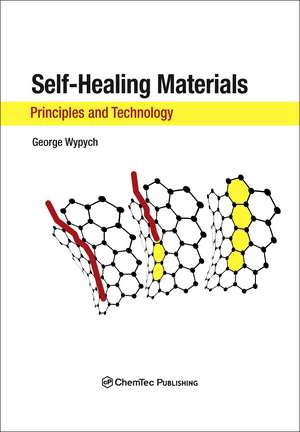Self-Healing Materials: Principles and Technology
Autor George Wypychen Limba Engleză Hardback – 30 mai 2017
The book first discusses the principal mechanisms of self-healing and how these are applied to the development of materials which have the ability to repair themselves—either with minimal human intervention or without human intervention at all. The book provides a theoretical background and a review of the major research undertaken to date, to give a thorough grounding in this concept and related technology.
The book specifically covers fault detection mechanisms in materials, and experimental methods to enable engineers to assess the efficiency of the self-healing process. It then discusses typical aids and additives in self-healing materials, including plasticizers, catalysts, shape-memory components, and more. Finally, the book contains real world examples of self-healing materials and how these have been applied to around 40 groups of products and industries, including materials used in the automotive industry, construction, composite materials for aerospace, biomaterials and materials used in medical devices, and adhesives and sealants.
- Helps materials scientists and engineers to reduce risk of degradation and materials failure by using self-healing materials in a range of applications
- Provides real world application examples, so practitioners can assess the applicability and usefulness of self-healing materials in their work
- Includes guidance on the efficiency and efficacy of self-healing mechanisms, with coverage of the different parameters to be considered, and methodologies to use
- Discusses typical aids and additives in self-healing materials, including plasticizers, catalysts, shape-memory components, and more
| Toate formatele și edițiile | Preț | Express |
|---|---|---|
| Hardback (2) | 1299.74 lei 5-7 săpt. | |
| ELSEVIER SCIENCE – 30 mai 2017 | 1299.74 lei 5-7 săpt. | |
| ELSEVIER SCIENCE – 24 mar 2022 | 1444.49 lei 5-7 săpt. |
Preț: 1299.74 lei
Preț vechi: 1990.08 lei
-35% Nou
Puncte Express: 1950
Preț estimativ în valută:
248.74€ • 258.73$ • 205.35£
248.74€ • 258.73$ • 205.35£
Carte tipărită la comandă
Livrare economică 07-21 aprilie
Preluare comenzi: 021 569.72.76
Specificații
ISBN-13: 9781927885239
ISBN-10: 192788523X
Pagini: 262
Dimensiuni: 152 x 229 x 20 mm
Greutate: 0.54 kg
Editura: ELSEVIER SCIENCE
ISBN-10: 192788523X
Pagini: 262
Dimensiuni: 152 x 229 x 20 mm
Greutate: 0.54 kg
Editura: ELSEVIER SCIENCE
Public țintă
smart materials, polymers, cracks, damage, repair, material failure, biomimetics, shape memory, degradation, biomedical, aerospace, composites, adhesives, mechanical stressCuprins
1. Introduction. Lessons from Living Things2. Mechanisms of Self-healing3. Chemical and Physical Processes Occurring During Self-Healing of Polymers4. Fault Detection Mechanisms5. Triggering and Tuning the Healing Processes6. Activation Energy of Self-Healing7. Means of Delivery of Healant to the Defect Location8. Self-healing Timescale9. Self-healing Extent10. Molecular Dynamics Simulation11. Morphology of Healing12. Selected Experimental Methods in Evaluation of Self-healing Efficiency13. Additives and Chemical Structures Used in Self-healing Technology14. Self-healing of Different Polymers15. Self-healing in Different Products
Recenzii
"I would strongly recommend this book to anyone with an interest in this growing field of self-healing materials. The chapters are brief, the references are excellent, though there are no problem sets. I found myself looking up several references that claimed my interest, and I credit the book with giving a clear and thorough overview of the field. Accordingly, readers should not expect details, but rather guidance toward future reading." --MRS Bulletin
